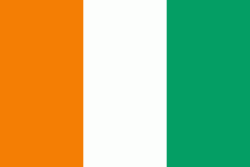Gagnoa Department (Gagnoa)
Gagnoa Department is a department of Gôh Region in Gôh-Djiboua District, Ivory Coast. In 2021, its population was 724,496 and its seat is the settlement of Gagnoa. The sub-prefectures of the department are Bayota, Dahiépa-Kéhi, Dignago, Dougroupalégnaoa, Doukouyo, Gagnoa, Galebre-Galébouo, Gnagbodougnoa, Guibéroua, Ouragahio, Sérihio, and Yopohué.
Gagnoa Department was created in 1969 as one of the 24 new departments that were created to take the place of the six departments that were being abolished. It was created from territory that was formerly part of Centre-Ouest Department. Using current boundaries as a reference, from 1969 to 1980 the department occupied the same territory as Gôh Region.
In 1980, Gagnoa Department was divided to create Oumé Department. In 1997, regions were introduced as new first-level subdivisions of Ivory Coast; as a result, all departments were converted into second-level subdivisions. Gagnoa Department was initially included in Haut-Sassandra Region, but in 2000 it was combined with Oumé Department to form the new Fromager Region.
In October 2005, Gagnoa Department was the base of Bangladeshi UNOCI troops aiming to secure the proposed presidential elections in the country.
In 2011, districts were introduced as new first-level subdivisions of Ivory Coast. At the same time, regions were reorganised and became second-level subdivisions and all departments were converted into third-level subdivisions. At this time, Gagnoa Department became part of Gôh Region in Gôh-Djiboua District.
Gagnoa Department was created in 1969 as one of the 24 new departments that were created to take the place of the six departments that were being abolished. It was created from territory that was formerly part of Centre-Ouest Department. Using current boundaries as a reference, from 1969 to 1980 the department occupied the same territory as Gôh Region.
In 1980, Gagnoa Department was divided to create Oumé Department. In 1997, regions were introduced as new first-level subdivisions of Ivory Coast; as a result, all departments were converted into second-level subdivisions. Gagnoa Department was initially included in Haut-Sassandra Region, but in 2000 it was combined with Oumé Department to form the new Fromager Region.
In October 2005, Gagnoa Department was the base of Bangladeshi UNOCI troops aiming to secure the proposed presidential elections in the country.
In 2011, districts were introduced as new first-level subdivisions of Ivory Coast. At the same time, regions were reorganised and became second-level subdivisions and all departments were converted into third-level subdivisions. At this time, Gagnoa Department became part of Gôh Region in Gôh-Djiboua District.
Map - Gagnoa Department (Gagnoa)
Map
Country - Côte_d'Ivoire
 |
 |
| Flag of Ivory Coast | |
Before its colonization by Europeans, Ivory Coast was home to several states, including Gyaaman, the Kong Empire, and Baoulé. The area became a protectorate of France in 1843 and was consolidated as a French colony in 1893 amid the European Scramble for Africa. It achieved independence in 1960, led by Félix Houphouët-Boigny, who ruled the country until 1993. Relatively stable by regional standards, Ivory Coast established close political-economic ties with its West African neighbours while maintaining close relations with the West, especially France. Its stability was diminished by a coup d'état in 1999, then two civil wars—first between 2002 and 2007 and again during 2010–2011. It adopted a new constitution in 2016.
Currency / Language
| ISO | Currency | Symbol | Significant figures |
|---|---|---|---|
| XOF | West African CFA franc | Fr | 0 |
| ISO | Language |
|---|---|
| FR | French language |















